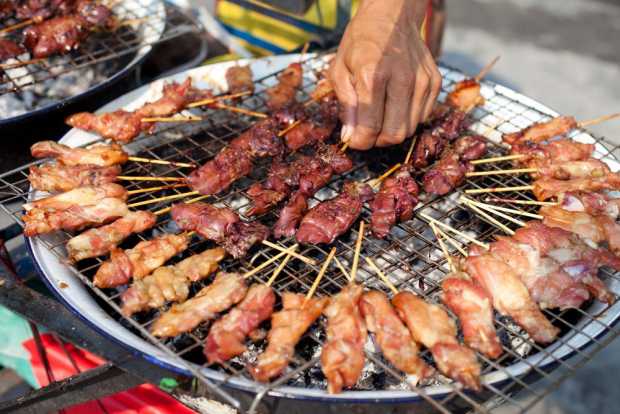Not a member yet? Sign Up!
Info
Please use real email address to activate your registration

Leave it to William Wongso, Indonesia’s famous culinary expert, renowned restaurateur, and food consultant to come up with an inimitable theme for a potluck party.
This month, for Potluck No. 9, ACMI/Aku Cinta Masakan Indonesia (I Love Indonesian Food), a group initiated by Wongso and Santhi Serad, a food scientist, decided to feature Aneka Sate (assorted satay) making participants, including us, do some diggings for heritage recipes.
The origin of satay
To make satay, the main ingredients (a choice of either beef, chicken, fish, or plant based pieces) are sliced or cubed, marinated, then grilled with charcoal and served with a variety of sauces.
According to Chef Daeng in satay.com, culinary experts that have studied the food patterns of Southeast Asia generally identify Indonesia as the origin of satay. When traders from other countries visited Indonesia, they took the recipe for Indonesian satay home with them. This led to the creation of separate but distinct satay in many countries.
There may be hundreds of satay varieties in the Indonesian Archipelago, but a few days before the ACMI bimonthly potluck, only eight people confirmed to participate. However, when the day finally came, more than 20 satay varieties were presented on ACMI communal table.
William Wongso and around 30 guests surrounded the long table, talked about all the satay featured, including which part of Indonesia they come from, the ingredients, the recipes, the cooking methods, the style and the taste.
Satay galore
It was amusing to see two types of satay that neither have skewers nor grilled. Those were sate dingin (marinated fish) and sate balanga Gorontalo that we presented. On Food Revolution Day 2014, a global food event initiated by Jamie Oliver, we also had this satay on the menu.
The scrumptious bite sizes also vary from satay to satay. The tiniest cut was sate daging (beef satay) by Chef Marco Lim, owner of Marco Padang Grill, a Padang Bistro specialized in Old Padang Peranakan Recipe and others Authentic Padang Cuisine @Marco_Padang. The largest cut of them all was sate bumbu khas Manado by Ade Putri Paramaditha, the Foodtective and host of the Food for Fun program at Female Radio in Jakarta.
Rahung Nasution @rahung, a documentary film maker who identified himself as a social traveler and a bogus chef, prepared sate tombur and sate arsik. Both are North Sumatera dishes using andaliman, a wild pepper that only grows in the highland over there. According to the Spice Trekkers, andaliman is a distant relative to Szechuan pepper, has a lemon flavor with the numbing bite of pepper and is perfect to season fish, seafood and poultry.
Chef Astrid Enricka, the co-owner Ayam Tangkap Atjeh Rayeuk @AyamTangkapAR , an eatery specializing on Aceh food in Jakarta, cooked sate sumsum. It is a unique sate made of beef bone marrow. Enricka balanced the fatty taste with a soury condiment made of mango slices, andaliman and lemon cui (small Chinese lemon common in North Sulawesi dishes).
The favorite satay
In between foodies chatting and snapping pictures of assorted satay on the table, William Wongso dished up a Vietnamese style sate la lot, beef wrapped in la lot leaves, complemented with fish sauce, chili and chopped peanuts. It was indeed a delicacy which sauce is perfect to be paired with all the satay featured.
Towards the end of the potluck, ACMI distributed small pieces of paper where all guests had to write down three of their favorite satay. Here are the favorites based on the guest’s choices:
Sate Tambulinas from Southeast Sulawesi by Nita Triyana @nitatriyana - beef satay with a mixture of coconut oil, lemon juice and spices.
Sate bumbu khas Manado by Ade Putri Paramaditha @missHOTRODqueen – Ade said this is how they serve the satay in Manado, in huge chunks.
Sate tulang Banjarmasin by Indri Seska @indriseska – this may be the only chicken satay that has bones since sate tulang is usually made from the backbone of a month old chicken.
Sate Balanga Gorontalo
Much to our surprise, sate balanga Gorontalo by Omar Niode Foundation @omarniode was also among the potluck favorites. This is the second time we had the ACMI honor, the first was Kua Bugis that we prepared for Potluck No. 8 in March.

Try the recipe of sate balanga Gorontalo, courtesy of Biko Mointi Boekoesoe of Talaga Cookery.
Ingredients: 1 kg of meat cut into small cubes.
Seasoning: 4 pieces of curly chili, 10 cloves of shallots, 4 cloves of garlic, 1 cm ginger, 2 cm galangal, 2 cm lemongrass, 30 pieces of fried peanuts, soy sauce and salt to taste.
Directions: 1) Blend all ingredients and mix into the cubed meats 2) Marinate for a while. 3) Cook until tender. 4) Add soy sauce.
---------------------------
Images – Cover: Lancelee/Shutterstock. All others: Omar Niode Foundation.